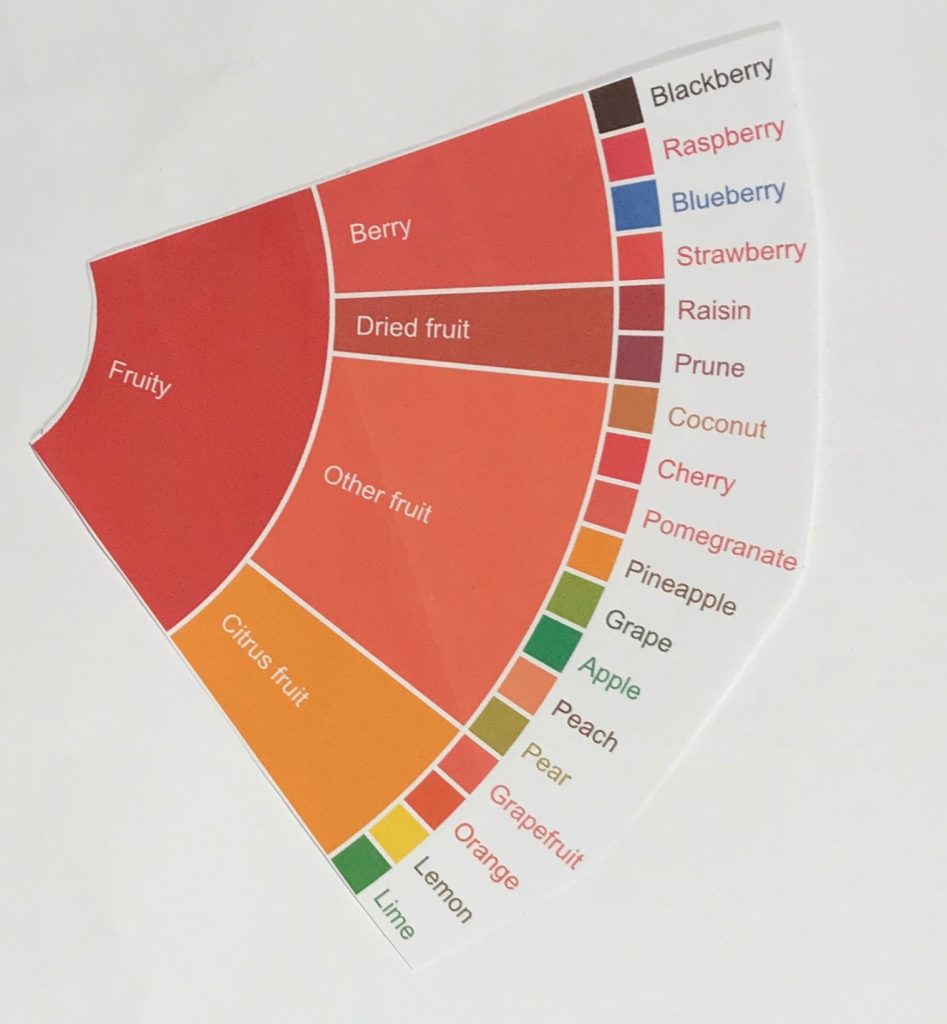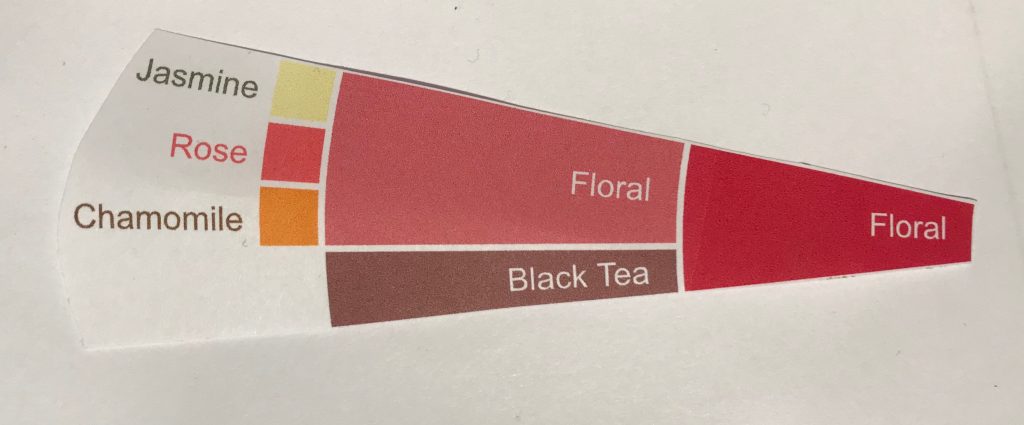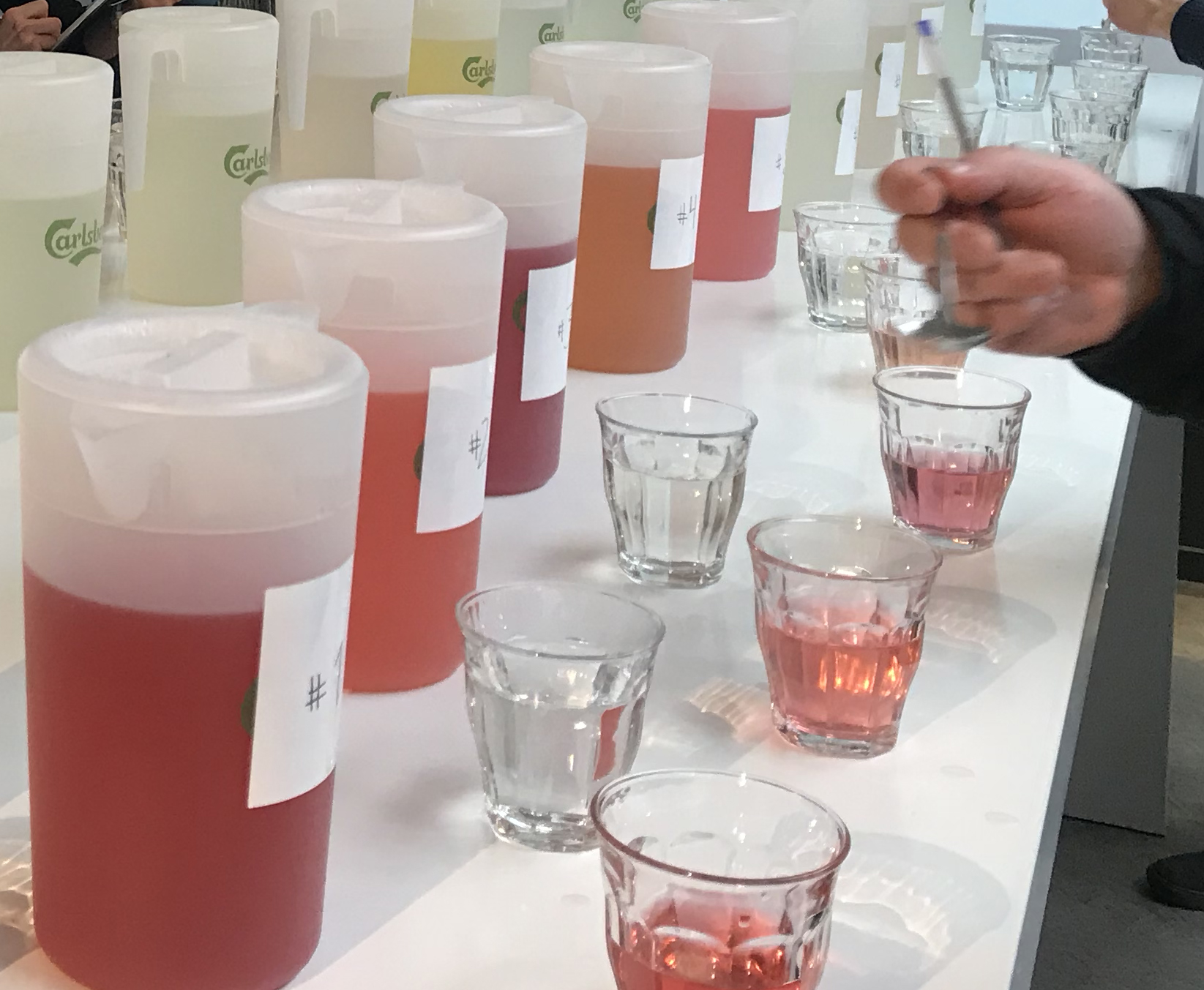At this year’s autumn cupping, we prepared a sensory workshop for all the attendees. It was a great success and people have been asking me to share how we did it. So, here it is, this blog post is going to guide you step by step so you can do it in your roastery or cafe too, are you ready? Let’s begin!
For the workshop, we wanted to focus on building a sensorial library.
By doing 4 different exercises
A. Getting to know the flavour wheel: Fruits & berries.
B. Getting to know the flavour wheel: Florals.
C. Organic Acids: 4 different organic acids.
D. Aroma in Coffee: Le nez du cafe
And below, you can read about how we did it, and what you need in order to do these exercises in your own roastery, or cafe !
A. Flavour wheel – Fruits & berries.

Needed for exercise
- Fresh fruits and berries, cut in pieces. 100 gram is sufficient to make 2 liters of solution.
- Hot water, 80 degrees celsius is fine.
- Containers for steep the fruit in
- Strainer, so you can get the fruit out
- Food colouring ( if you want to make this one even harder than it already is)
Chop fruits and berries, take 100 grams of fruit and put in container.
Pour hot water over, and let it sit for at least 10 hours.
And don’t worry, even though the solution is cold, it’s very intense.
Strain the fruit out and pour into cupping bowls or glasses.

Here is a list of what fruits and berries we used:
YYY: Lemon
XXX: Lime
BBB: Green apple
AAA: Grapefruit
MMM: Blackberry
RRR: Raspberry
QQQ: Blueberry
VVV: Pear
LLL: Grapes
FFF: Strawberry
SSS: Red Apple
Flavour is based on memory. You have to have tasted something in order to name it!
So this is an excellent exercise to build your library and become an even better taster !
B. Flavour Wheel – Florals

Needed for exercise
- Dried (or fresh if you can find it!) EDIBLE flowers, we used 20 grams.
→ I’m gonna mention this again, only use flowers you actually can consume.
- Hot water, 70 degrees celsius. Temperature is more important here, to avoid bitterness.
- Containers for steep the flowers in
- Strainer, so you can get the flowers out
- Food colouring ( if you want to make this one even harder than it already is)
For this exercise, I had bought different dried flowers.
( I am sorry, could not get fresh ones)
My favourite shops for dried edible flowers are:
uncleroys or Dried Edible Flowers
Pop the dried flowers into the container, and pour hot water over it and let it extract for around 10 hours.
Strain and pour into cupping bowls or glasses.
Here is a list of what we used, and you can do this with any edible flowers.
ËËË: Jasmine
ÅÅÅ: Lavender
ØØØ: Rose
HOHO: Hibiscus
üüü: Chamomile
C. Organic Acids
Needed for exercise
- Different organic acids. Can be bought here.
- Clean boiled water
- Cupping bowls
For this exercise,
Boil water, let it cool to around 50 degrees celsius.
Drip 10 drops into cup, and add water.
You have to find your own balance here. Some people find this exercise super difficult, other nails it immediately.
So try a couple of times before you test other people.
You can also brew a low dose brew, of a mild washed coffee and add acids.
But we tasted them just in water. To make a point, and to learn the differences.
Our next step will be to do organic acids in a brewed coffee.
Acetic acid
- is the compound that gives vinegar its pungent smell and sour taste. At low concentrations, it can be perceived as a mildly fruity flavor.
Citric acid
- is the dominant acid in, you might expect, citrus fruits.
Malic acid
- is the acid that contributes to the soury taste of green apples and tart taste in wines.
Phosphoric acid
- is a mineral inorganic acid used primary to add brightness to soft drinks. Feels like a buzzing sensation on the tongue rather than a taste.
Acids as function of roast weight loss (%):
Thanks to Coffee Chemistry for all the great info on this topic <3
We love you!
And then last but not least,
D. The Olfactory test
Needed for exercise
- Le Nez du Cafe kit for coffee 36 piece kit ( preferably 2)
- Blue/dark electrical tape
So , make an answer sheet for yourself. Pick out 9 different scents.
Note down their numbers, tape around the vials, so no number or colour is shown.
The goal of the exercise, is to get to know the different aromas.
The kits contain 36 aromatic scents found in the fragrance and aroma of coffee.
Le Nez du Cafe tests are grouped by category, corresponding to the popular SCAA Art of Aroma 4-poster set:
- enzymatic
- sugar browning
- dry distillation and
- aromatic taints.

Le Nez du Cafe kit for coffee 36 piece kit. Photo by Meng Han, Chau.
Thank you all for reading to the end, if you find it useful feel free to share on your social media. Also, if you have any problems or questions just write us an email we are more than happy to help.
Cheers!
Special thanks to Meng Han who edited this article and provided photos.
——————————————–
Sources
Coffee Roasters Guild
https://sca.coffee/
https://www.coffeechemistry.com/chemistry/acids


0 Comments